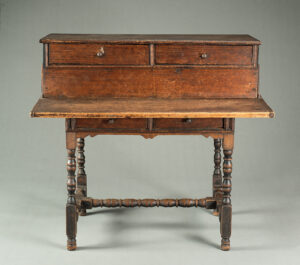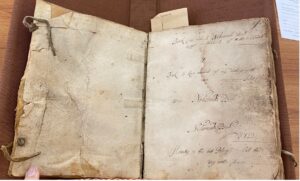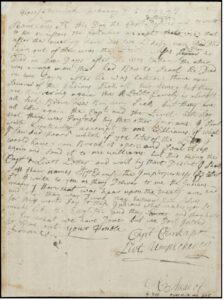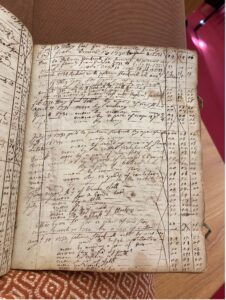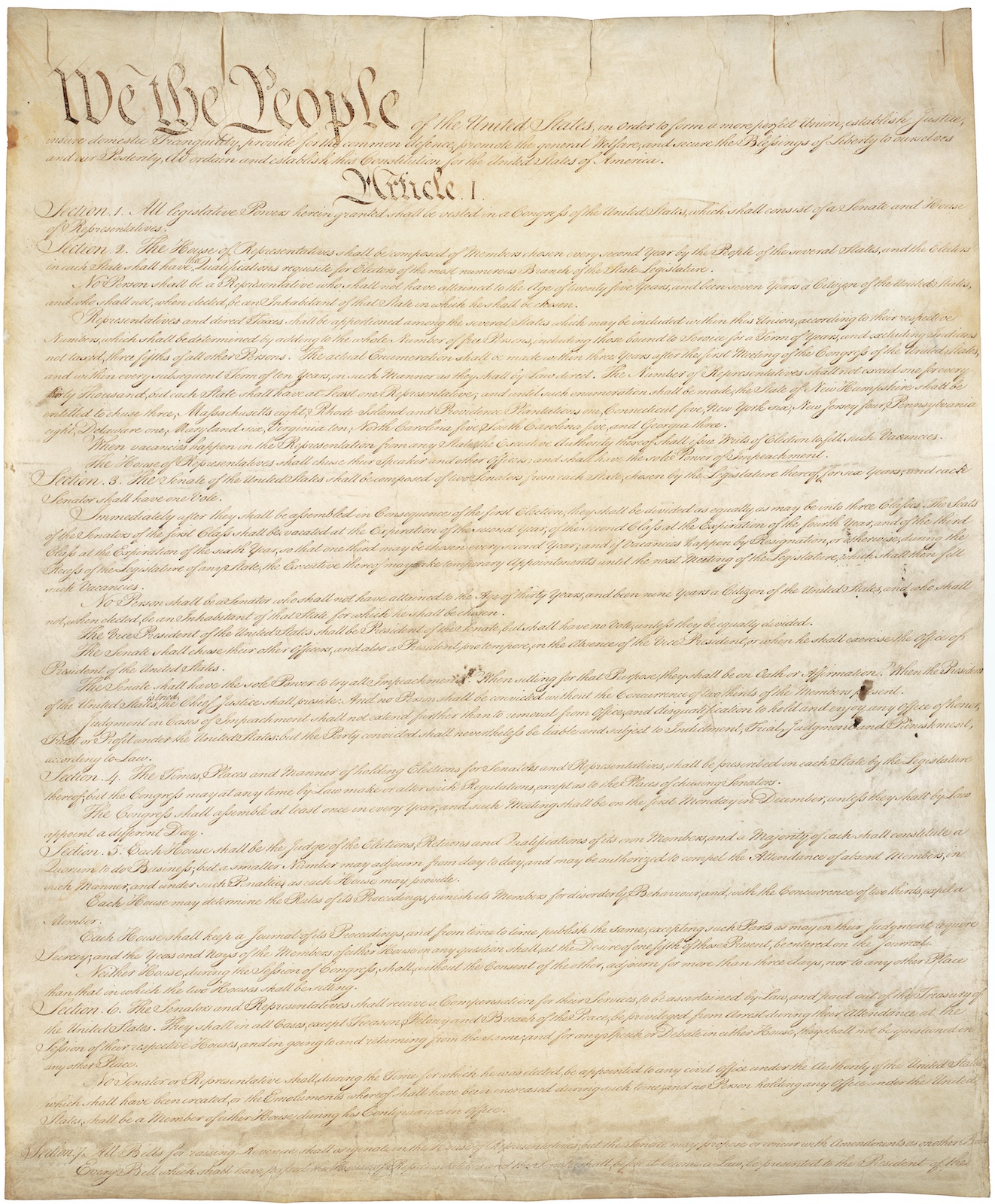A desk made of pine and maple sits in the corner of the study. Its turned legs gesture at its decorative appeal, while the spacious writing table and drawers hint at its functionality. It is easy, perhaps too easy, to imagine its owner—an eighteenth-century Massachusetts minister—sitting down to conduct both earthly and religious affairs. Historians have long imagined what desks like this one may have meant to the ministers who sat before them to read and write. But these imaginings only offer a partial view. The reality was considerably busier. Such a desk would have seen regular daily traffic, as it occupied a multifunctional space and witnessed far more interaction both upon and around it. What happens when we repopulate the room and consider the many women and men who interacted with such a furnishing? How might we use this object to think about these diverse lives all taking place within this shared space? What happens when we place furniture into a context of lively and fraught interaction?
A Minister’s Desk? Reanimating Space, Rethinking Furniture
What happens when we place furniture into a context of lively and fraught interaction?
The desk, dated to the 1690s, has seen the homes of several New England ministers. Curators speculate that it may have first belonged to the minister Edward Taylor (1640s-1729) before it came to reside in the home of Nehemiah Bull (1701-1740) of Westfield, Massachusetts. While Taylor’s ownership remains speculative, Bull made his ownership known by signing his name to the bottom of one of the drawers in a large but neat script that has been confirmed as a match with his signature in a surviving daybook. Today, both desk and daybook are owned by Historic Deerfield and the desk sits on display in the study of the eighteenth-century Ashley home, the residence of the Reverend Jonathan Ashley (1712-1780). Although we do not know what Bull’s house looked like, we can presume that the desk sat in a study like Ashley’s, or in a chamber that served at least part time as a study for the minister. In this space, the desk would have served practical functions while also acting as a status symbol, shoring up Bull’s authority as a household head, minister, and prominent figure in the community. Its design—especially its turned legs—suggest it was intended with outward display in mind. While Bull was likely the desk’s primary sitter, it would have had meaning as well for all those who lived in and visited the home.
Bull’s house, where the desk lived for several years, was bustling. There was his wife Elizabeth and their three children as well as many non-kin members of the household that came and went. Nehemiah and his wife were enslavers, and there were at least three enslaved people who lived in their home, three women named Tanner, Phillis, and Dido, who were all included in Bull’s inventory at his death in 1740. Additionally, the couple regularly hired white women who served as maids for various and sometimes overlapping periods of time ranging from a few months to multiple years. Others came as laborers, boarders, and students. For example, there was Benjamin Collam’s son who came to board, Hannah Dewey who came for “service,” Jacob (“a young Indian”) to board, Edward Coats to “live,” and Tim Woodbridge who came “to board with me and to be instructed.” Others came to “school” but may not have necessarily boarded in the house. At times, the house was so full that Bull was forced to board laborers in his neighbors’ homes. As we imagine the life of this desk, we must place it within this lively space.
For Bull, the desk may have symbolized a retreat from the noise of the home, a place to carve out relative privacy. This was often how Bull’s contemporaries described their time in their studies. The minister Jonathan Edwards (1703-1758), for example, was known to have spent up to thirteen hours a day in his study. Bull’s slightly earlier contemporary, the minister Peter Thacher (1651-1727) of Milton, Massachusetts, was perhaps less extreme, but habitually wrote of working independently in his study, sometimes to little avail, as when he wrote in November 1684: “I did little in my study tho I did something.” Thacher’s seclusion in his study rested on a system of racial and class-based unfreedom that his diary laid bare, a reality that was true for Bull as well, who was ordained as a minister in 1726. In the above entry, immediately after indicating that he had worked in his study, Thacher added a note “Ebed and Ephraim plowed.” By this, he referred to the labor of his enslaved and indentured laborers that made his studying possible. The same was almost certainly true of Bull’s household; the labor of his enslaved laborers, Tanner, Phillis, and Dido, as well as his many hired and indentured workers allowed Bull the occasional quiet time in his study to read, write, and think at the desk.
In part, the study—and the desk itself—may have demarcated spiritual space in the minister’s home. Ministers like Bull, Thacher, and Edwards retreated to their studies in attempts to gain distance not only from other members of their household but also from temporal concerns. Bull would have read and written sermons at the desk, prepared for the Sabbath, and carried out spiritual work and reflection in this space. While many of these activities were solitary, the desk may have symbolized a spiritual space for others who entered the chamber, whether to receive religious instruction or to engage in theological discussions with Bull. This was the case for Peter Thacher, who described how his maid Lidea would approach him in his study to discuss her spiritual state. At the desk, Bull may have conducted much of his inner religious life, just as he may have communed with other members of the household and community about spiritual affairs. We might ask how members of his household—especially those who were enslaved or otherwise unfree—might have seen and interacted with the desk, given its association with Bull’s religious duties. It is quite possible that members of Bull’s household would have regarded the desk as an anchor of spiritual space within the home.
Even as the desk may have been a space for spiritual work, Bull would have struggled to keep this fully separate from his temporal affairs, these multiple demands converging on the writing surface of the desk, where Bull brought quill to parchment. The varied nature of writings produced at this desk are reflective of this, as they covered both worldly and religious concerns, some public and others private. Surviving records offer a glimpse of the types of materials that crossed his desk. In addition to sermons, Bull wrote letters to fellow theologians like Solomon Williams, some of which survive today at the Pocumtuck Valley Memorial Association (PVMA) Library, just up the road from the Ashley house. Bull likewise may have been sitting at this very desk when he opened and read a 1734/5 letter from Konkapot and Umpachenee, which alerted him that members of their tribe had been poisoned. Presuming he followed Konkapot and Umpachenee’s instructions, after breaking the letter open and reading it, he sealed it up again and sent it along to Reverend Stephen Williams of Longmeadow. To this end, we might imagine that Bull used this desk to read and draft correspondence concerning his affairs in establishing a mission at Stockbridge in the 1730s. Although only a small fragment of Bull’s incoming and outgoing correspondence survives, the desk offers a reminder of Bull’s assorted affairs from family matters to theological concerns to his interest in the Stockbridge mission.
In addition to writing and receiving letters, Nehemiah Bull likely sat at this desk with his daybook, which also survives at the PVMA library. As Bull recorded on the title page, this book was an “account of my dealings with men.” The book—kept throughout the 1720s and 30s—gives a sense of Bull’s personality and perhaps how he interacted with members of his household, as he inscribed on the title page his motto: “Honesty is the best policy! Let this be my motto forever.” The bulk of the pages included notes about debts due to friends and neighbors as well as those owed to Bull. He also used the space to record the dates when various laborers came into his home and their accounts with him. The book was large enough that Bull probably did not carry it with him on daily errands but instead may have stored it on the desk where he could lay open its pages and mark his accounts.
Although Bull would have spent much independent time in his study, his accounting practice occasionally required the collaboration of those in his household. For example, his wife, Elizabeth may have kept her own accounts—either in a book of her own, or in some other style like the many women who recorded accounts with chalk tally marks. She may have joined him at the desk, perhaps standing alongside it or sitting close by as he confirmed with her these accounts. In other cases, she may have made her own marks in his book, a collaborative accounting practice that comes across in other account books of this era.
The pair hired several maids, who would have likely fallen under Elizabeth’s purview, and Bull may have turned to Elizabeth for clarification about their accounts. Likewise, he may have called some of these women—Patience Stockwell, Esther Lyon, or Ruth Trumble, just to name a few—to the desk when it was time to settle accounts, as when Peter Thacher described calling his maid Lidea into his study where he “discoursed her concerning her going home . . . and paid her what I owed her.” More regularly, though, Bull may have relied on enslaved, indentured, and hired members of his household to assist with his accounts. In their aprons, Tanner, Phillis, and Dido may have stuffed receipts from local merchants like Samuel Barnard after returning from his shop, presenting these to their enslavers as proof of their errands. In cases like these, we can imagine the daybook sitting open on Bull’s desk, its contents shaping his interactions with various members of the household.
Just as Bull may have called members of the household to assist him at his desk, this too may have served as a place where Bull conducted affairs with friends, neighbors, members of the church, and various others. When he filed a suit with his congregation for his salary, for example, the sheriff or other legal officials may have brought their paperwork to this space. When he met with relatives or members of the town to bring in apprentices, their indentures may have been signed on this very surface. And when he signed deeds for land at Stockbridge, or other bills of credit, he and others may have gathered around this desk space.
Some of these transactions would have pulled in members of his household to sign as witnesses. In many cases, they may have stood on the side of the desk when they signed, their marks and signatures appearing sideways on the page as some of these surviving papers show. Even when they did not officially witness and sign documents, diverse members of Bull’s household listened in and watched on as these activities were carried out. Perhaps they were busy sweeping the room, polishing the silver, or spinning wool, but in the multifunctional rooms of an eighteenth-century house it was common for laboring people to inadvertently act as witnesses to the household head’s dealings. We might ask what they would have taken from these interactions? Might such affairs have shaped their ability to navigate the courts or to plot potential routes out of bondage? What words and practices did they glean from the public affairs in this space?
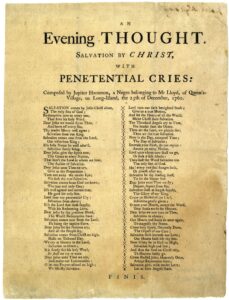
In addition to a space for carrying out business, Bull’s study—and his desk—were spaces of instruction and may have been occupied by Bull’s various students. Several young men in Deerfield came to Bull’s house for schooling, often boarding in the house while they received instruction. While his students were mostly white men and boys, Bull too has been recognized as an early teacher for Jupiter Hammon, who became one of the earliest known Black writers in America. Although the story goes that Bull carried out this training in the library of the Lloyd Manor Estate in New York, it is possible that Bull may have taken on other African American students, enslaved or free, in the Deerfield area. Tanner, Phillis, and Dido, or any other enslaved people who lived in his household may too have received some schooling from Bull, perhaps using the desk’s writing surface during their lessons. Bull’s daybook provides some evidence of this type of instruction, as there are several pages that appear to have been used for practice writing—possibly by Bull but just as likely by some of his children and students.
The desk may have been a curiosity to his household, not only for what activities happened on and around it, but for the things stored within its drawers. The desk has four drawers, but only two are immediately visible when facing the desk; the other two have been somewhat ingeniously built into the sides of the desk, allowing for significantly more storage space. Notably, none of these drawers ever held locks, providing easy access to those interested in peeking at the contents. Unlike the somewhat ubiquitous chests of this period which opened from the top and would have required rifling through miscellaneous storage items like linens to find any stored papers, this desk left papers rather accessible.
These papers may have been objects of fascination to members of Bull’s household, especially since enslaved and unfree people in New England—even those who were illiterate—were likely familiar with the power of writing. Papers could lead to pain and separation as with a bill of sale, just as they could lead to relative freedoms in daily life as with passes and currency notes. For indentured members of the household, indenture papers offer another example of the power of the written word, as indentures could provide important proof of freedom dues or of service terms. Of course, Bull may have taken this into consideration with what he stored in this desk and what he kept elsewhere, perhaps in a locked box or drawer, just as he may have placed more confidential items in the side drawers, which may have been slightly less visible to onlookers, depending on how the desk was positioned in his home. The desk’s deep drawers, now empty, invite many questions about what was stored there but also about how members of Bull’s household may have interacted with them. Might they have slid the drawers open when Bull was out of the home carrying out social and business affairs? Would the papers inside have made any sense to those who viewed them? What types of information did they provide?

When we encounter this desk as visitors, it is easy to see Nehemiah Bull sitting alone at it. This is perhaps for good reason as the desk was a symbol of his position in the church and in colonial society as well as his authority as male household head. It would also have been a space that he sometimes went for solitude. But while visitors today enter empty homes and are met with a static world, the eighteenth century was far from this. When we repopulate the room, we must consider additional interactions around the desk. Artifacts like the Bull desk recall all types of stories of the diverse people who made these objects and interacted with them. When we bring this world into motion again, we are greeted with a much richer and more diverse view of colonial America.
Acknowledgements
The research for this article was carried out thanks to a New England Regional Consortium Fellowship, with special thanks to Dan Sousa, furniture curator at Historic Deerfield, for showing me the desk and the drawer with Bull’s signature. Thank you as well to Karin Wulf, Kristen Beales, and Alison Bazylinski for reading early drafts of this article.
Further Reading
On desks and colonial storage furniture, see Wilson H. Kimnach and Kenneth P. Minkema, “The Material and Social Practices of Intellectual Work: Jonathan Edward’s Study,” William and Mary Quarterly 69 (Oct. 2012): 684; Gerald W. R. Ward, “The Merchants’ Real Friend and Companion” in Boston Furniture, 1700-1900, ed. Brock Jobe and Gerald W.R. Ward (Boston: Colonial Society of Massachusetts, 2016), 166-179; A Place for Everything: Chests and Boxes in Early Colonial America (Winterthur, Delaware: Henry Francis du Pont Winterthur Museum, 1986); Brock Jobe and Myrna Kate, New England Furniture: The Colonial Era (Boston: Houghton Mifflin Company, 1984).
On the Nehemiah Bull desk, see Katherine Fecteau, “It’s a Bird! It’s a Plane! It’s … a table-desk” Past@present blog, Umass Amherst Department of History, https://umasshistory.wordpress.com/2016/07/25/historic-deerfield-internship/; “An Historic Desk from Before Desks Were Desks” The Appraisal Group, https://appraisalgroupusa.com/an-historic-desk-from-before-desks-were-desks/; Robert Rober, “Besides historic desk, Rev. Bull owned people,” Daily Hampshire Gazette, April 25, 2016 https://www.gazettenet.com/Romer-letter-1612543.
On Nehemiah Bull’s involvement in Stockbridge, see Patrick Frazier, The Mohicans of Stockbridge (Lincoln: University of Nebraska Press, 1992). On Bull as teacher to Jupiter Hammon see Leslie M. Harris, In the Shadow of Slavery: African Americans in New York City, 1626-1683 (Chicago: University of Chicago Press, 2003), 66.
On manuscript culture in early America, see Catherine La Courreye Blecki, “Reading Moore’s Book: Manuscripts vs. Print Culture and the Development of Early American Literature,” in Milcah Martha Moore’s Book: A Commonplace Book from Revolutionary America, ed. Catherine La Courreye Blecki and Karin A. Wulf (University Park: The Pennsylvania State University Press, 1997), 59-106.
On slavery in Deerfield and western Massachusetts, see Gretchen Holbrook Gerzina, Mr. and Mrs. Prince: How an Extraordinary Eighteenth-Century Family Moved out of Slavery and Into Legend (New York: Harper Collins, 2008); C.S. Manegold, Ten Hills Farm: The Forgotten History of Slavery in the North (Princeton: Princeton University Press, 2010); Robert H. Robert, Slavery in the Connecticut Valley of Massachusetts (Florence, Massachusetts: Levellers Press, 2009); Marla R. Miller, Entangled Lives: Labor, Livelihood and Landscapes of Change in Rural Massachusetts (Baltimore: Johns Hopkins Press, 2020).
On enslaved people and space, see Dell Upton, “White and Black Landscapes in Eighteenth-Century Virginia,” Places 2 (no. 2, 1984): 59-72; Bernard L. Herman, Town House: Architecture and Material Life in the Early American City, 1780-1830 (Chapel Hill: University of North Carolina Press, 2005); John Michael Vlach, Back of the Big House: The Architecture of Plantation Slavery (Chapel Hill: University of North Carolina Press, 1993); Rhys Isaac, The Transformation of Virginia 1740-1790 (Chapel Hill: University of North Carolina Press, Published for the Omohundro Institute of Early American History & Culture, 2012; 1999); Stephanie M. H. Camp, Closer to Freedom: Everyday Resistance in the Plantation South (Chapel Hill: University of North Carolina Press, 2004); Marisa Fuentes, Dispossessed Lives: Enslaved Women, Violence, and the Archive (Philadelphia: University of Pennsylvania Press, 2015); Katherine McKittrick, Demonic Grounds: Black Women and the Cartographies of Struggle (Minneapolis: University of Minneapolis Press, 2006).
This article originally appeared in September, 2022.
Caylin Carbonell is currently a postdoctoral fellow at the Omohundro Institute of Early American History & Culture. She is a historian of race, gender, and power with a focus on the lived experiences of unfreedom in early New England. Her book project, Laboring Lives: Households, Dependence, and Power in Colonial New England, uses innovative archival practices to reveal stories of the everyday lives of diverse New Englanders.



